Management and Leadership Theories Application in Debenhams
VerifiedAdded on 2024/06/07
|23
|5182
|481
Report
AI Summary
This report defines and compares the roles and characteristics of leaders and managers, using Debenhams as a case study. It examines how these roles apply in different situational contexts, including stable, slow-to-moderate changing, and fast-changing environments. The report also applies various leadership theories and models, such as situational leadership and systems leadership, to Debenhams, discussing the functions of managers based on Fayol's principles and Mintzberg's managerial roles. Furthermore, it explores Robert House's leadership styles, including supportive, achievement-oriented, directive, and participative leadership, highlighting the importance of adapting leadership approaches to different organizational situations within Debenhams. Desklib provides this report and many other resources for students.
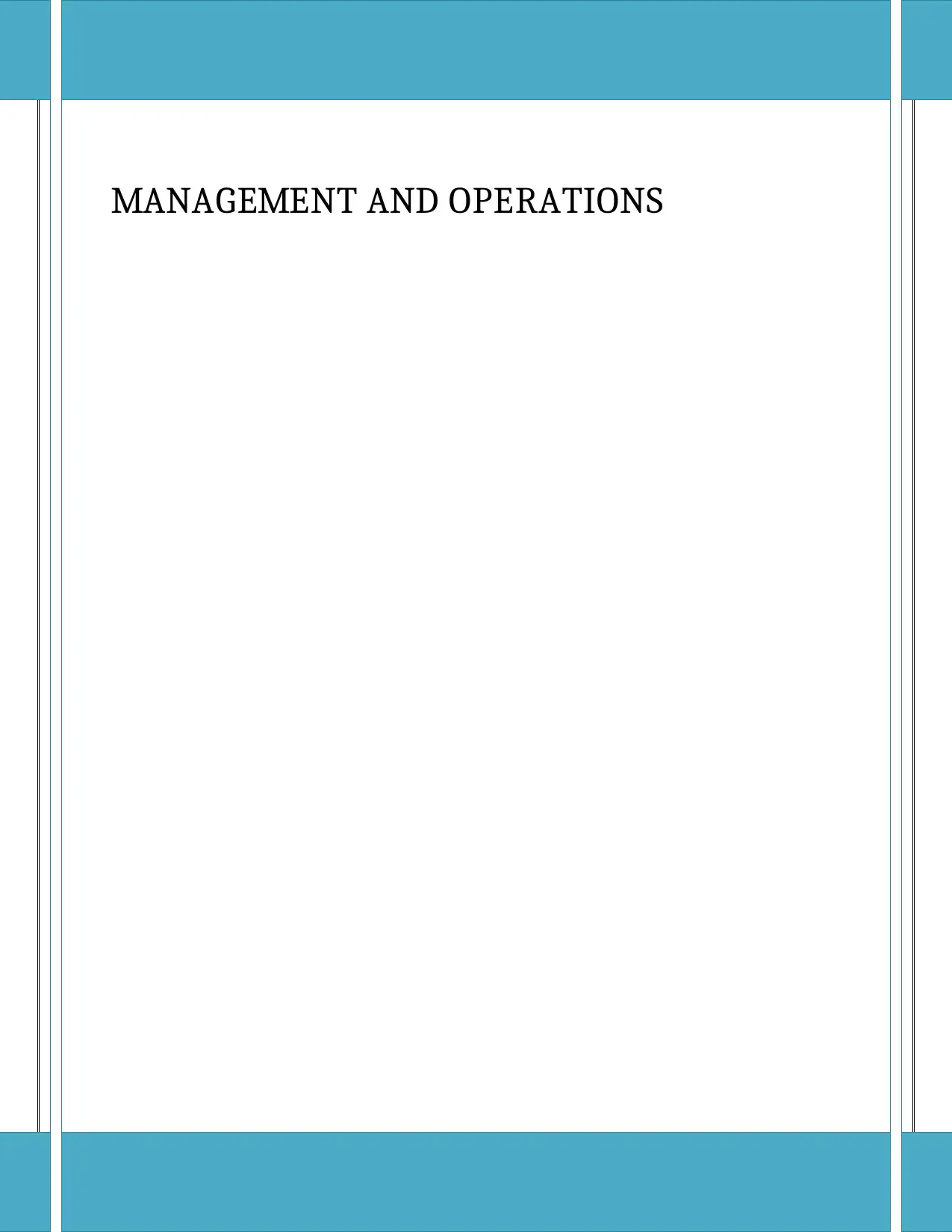
MANAGEMENT AND OPERATIONS
Paraphrase This Document
Need a fresh take? Get an instant paraphrase of this document with our AI Paraphraser
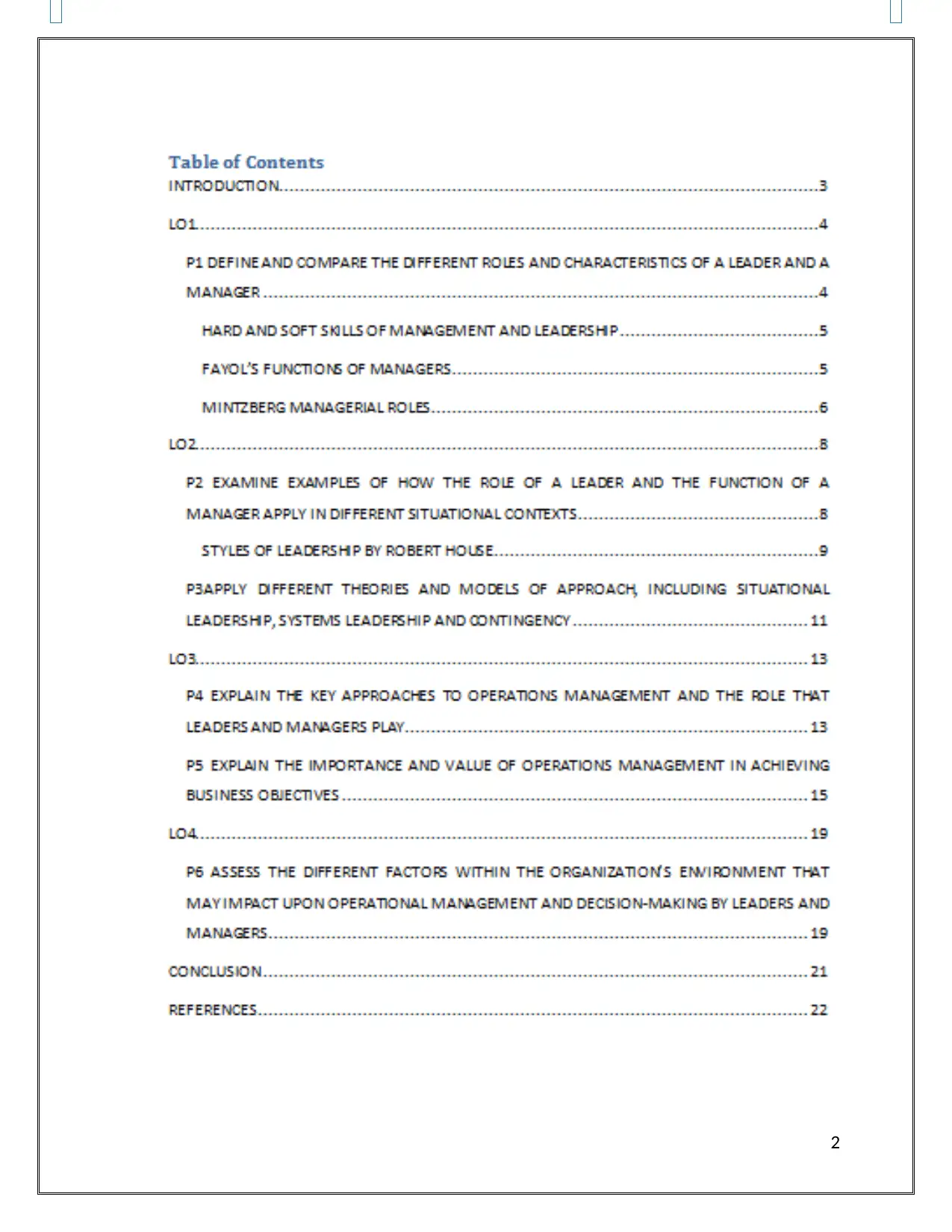
2
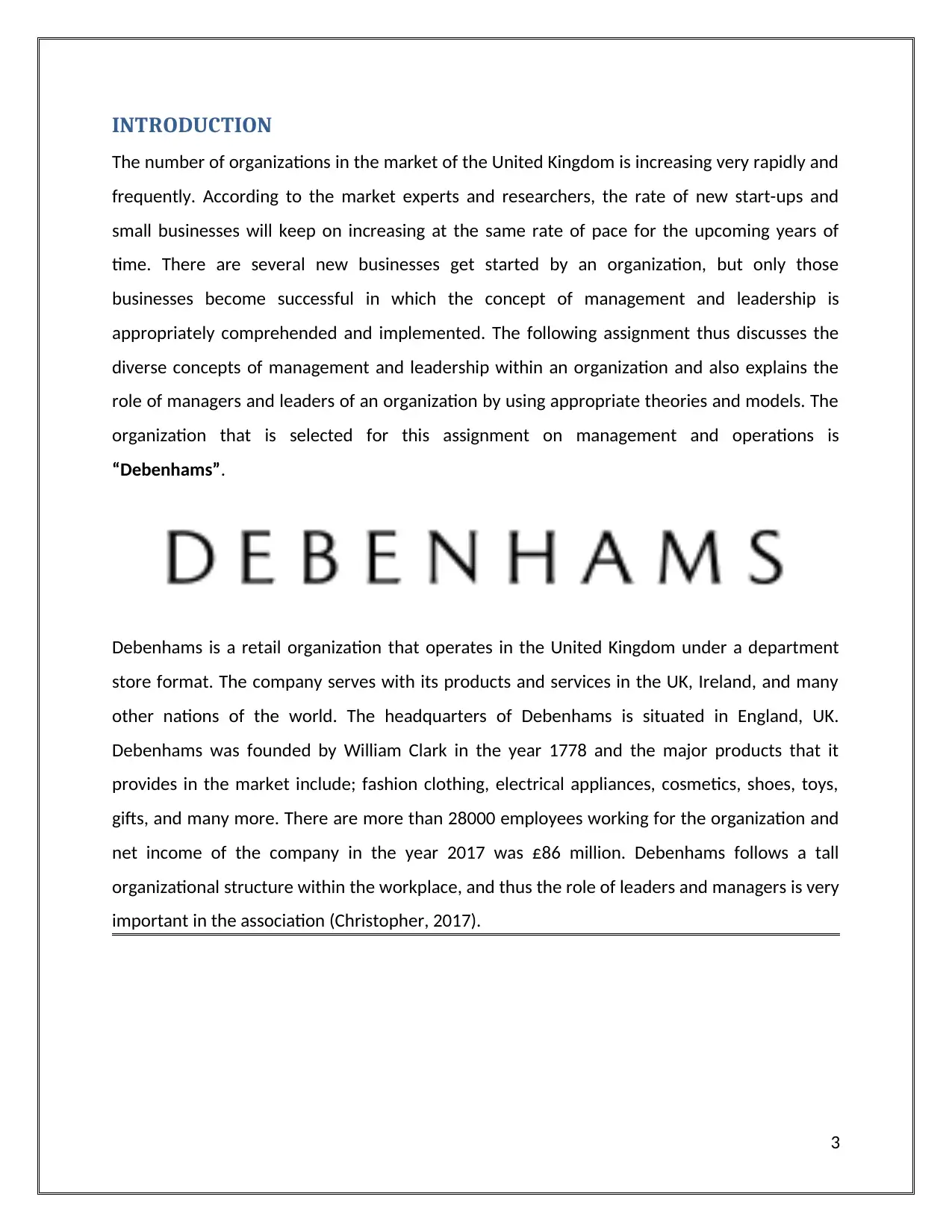
INTRODUCTION
The number of organizations in the market of the United Kingdom is increasing very rapidly and
frequently. According to the market experts and researchers, the rate of new start-ups and
small businesses will keep on increasing at the same rate of pace for the upcoming years of
time. There are several new businesses get started by an organization, but only those
businesses become successful in which the concept of management and leadership is
appropriately comprehended and implemented. The following assignment thus discusses the
diverse concepts of management and leadership within an organization and also explains the
role of managers and leaders of an organization by using appropriate theories and models. The
organization that is selected for this assignment on management and operations is
“Debenhams”.
Debenhams is a retail organization that operates in the United Kingdom under a department
store format. The company serves with its products and services in the UK, Ireland, and many
other nations of the world. The headquarters of Debenhams is situated in England, UK.
Debenhams was founded by William Clark in the year 1778 and the major products that it
provides in the market include; fashion clothing, electrical appliances, cosmetics, shoes, toys,
gifts, and many more. There are more than 28000 employees working for the organization and
net income of the company in the year 2017 was £86 million. Debenhams follows a tall
organizational structure within the workplace, and thus the role of leaders and managers is very
important in the association (Christopher, 2017).
3
The number of organizations in the market of the United Kingdom is increasing very rapidly and
frequently. According to the market experts and researchers, the rate of new start-ups and
small businesses will keep on increasing at the same rate of pace for the upcoming years of
time. There are several new businesses get started by an organization, but only those
businesses become successful in which the concept of management and leadership is
appropriately comprehended and implemented. The following assignment thus discusses the
diverse concepts of management and leadership within an organization and also explains the
role of managers and leaders of an organization by using appropriate theories and models. The
organization that is selected for this assignment on management and operations is
“Debenhams”.
Debenhams is a retail organization that operates in the United Kingdom under a department
store format. The company serves with its products and services in the UK, Ireland, and many
other nations of the world. The headquarters of Debenhams is situated in England, UK.
Debenhams was founded by William Clark in the year 1778 and the major products that it
provides in the market include; fashion clothing, electrical appliances, cosmetics, shoes, toys,
gifts, and many more. There are more than 28000 employees working for the organization and
net income of the company in the year 2017 was £86 million. Debenhams follows a tall
organizational structure within the workplace, and thus the role of leaders and managers is very
important in the association (Christopher, 2017).
3
⊘ This is a preview!⊘
Do you want full access?
Subscribe today to unlock all pages.

Trusted by 1+ million students worldwide
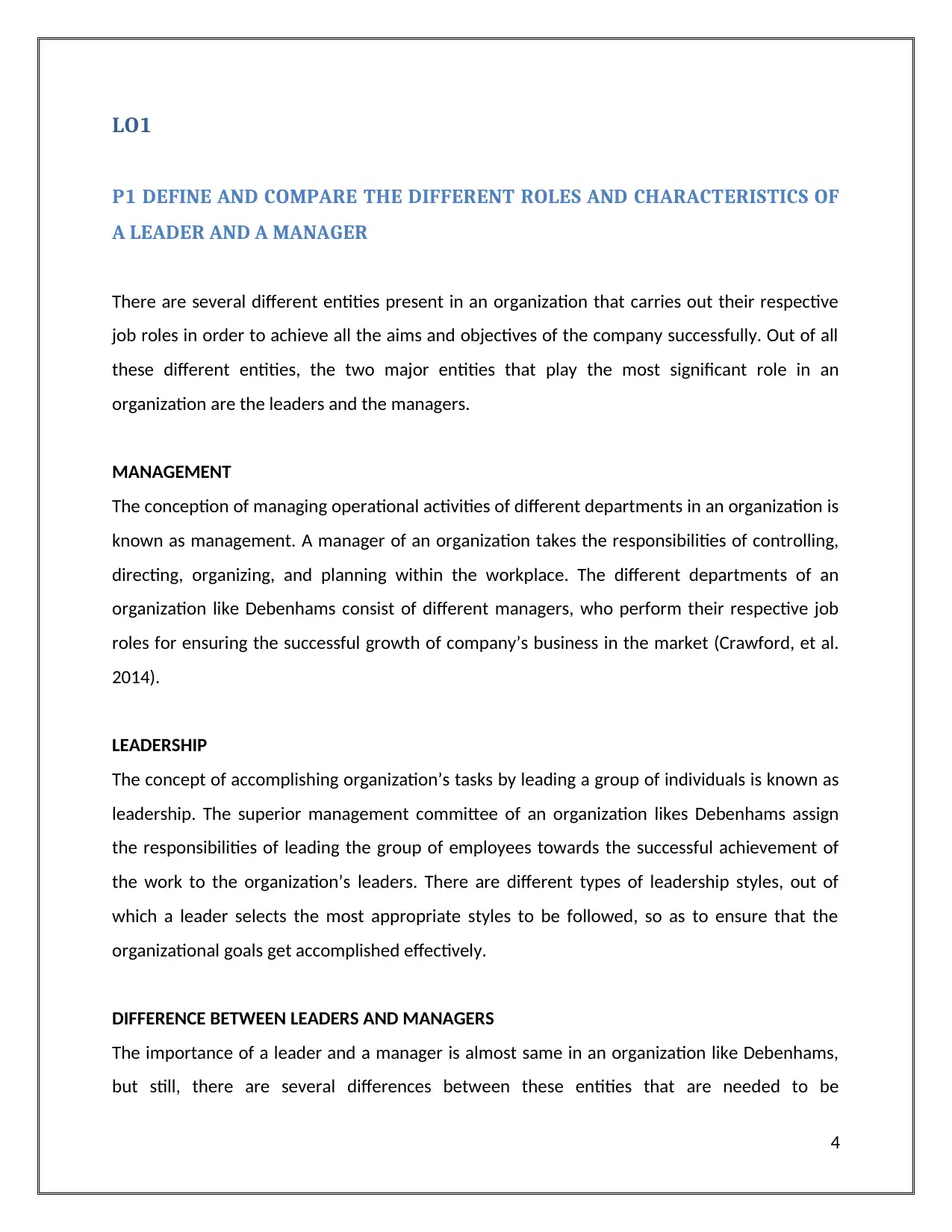
LO1
P1 DEFINE AND COMPARE THE DIFFERENT ROLES AND CHARACTERISTICS OF
A LEADER AND A MANAGER
There are several different entities present in an organization that carries out their respective
job roles in order to achieve all the aims and objectives of the company successfully. Out of all
these different entities, the two major entities that play the most significant role in an
organization are the leaders and the managers.
MANAGEMENT
The conception of managing operational activities of different departments in an organization is
known as management. A manager of an organization takes the responsibilities of controlling,
directing, organizing, and planning within the workplace. The different departments of an
organization like Debenhams consist of different managers, who perform their respective job
roles for ensuring the successful growth of company’s business in the market (Crawford, et al.
2014).
LEADERSHIP
The concept of accomplishing organization’s tasks by leading a group of individuals is known as
leadership. The superior management committee of an organization likes Debenhams assign
the responsibilities of leading the group of employees towards the successful achievement of
the work to the organization’s leaders. There are different types of leadership styles, out of
which a leader selects the most appropriate styles to be followed, so as to ensure that the
organizational goals get accomplished effectively.
DIFFERENCE BETWEEN LEADERS AND MANAGERS
The importance of a leader and a manager is almost same in an organization like Debenhams,
but still, there are several differences between these entities that are needed to be
4
P1 DEFINE AND COMPARE THE DIFFERENT ROLES AND CHARACTERISTICS OF
A LEADER AND A MANAGER
There are several different entities present in an organization that carries out their respective
job roles in order to achieve all the aims and objectives of the company successfully. Out of all
these different entities, the two major entities that play the most significant role in an
organization are the leaders and the managers.
MANAGEMENT
The conception of managing operational activities of different departments in an organization is
known as management. A manager of an organization takes the responsibilities of controlling,
directing, organizing, and planning within the workplace. The different departments of an
organization like Debenhams consist of different managers, who perform their respective job
roles for ensuring the successful growth of company’s business in the market (Crawford, et al.
2014).
LEADERSHIP
The concept of accomplishing organization’s tasks by leading a group of individuals is known as
leadership. The superior management committee of an organization likes Debenhams assign
the responsibilities of leading the group of employees towards the successful achievement of
the work to the organization’s leaders. There are different types of leadership styles, out of
which a leader selects the most appropriate styles to be followed, so as to ensure that the
organizational goals get accomplished effectively.
DIFFERENCE BETWEEN LEADERS AND MANAGERS
The importance of a leader and a manager is almost same in an organization like Debenhams,
but still, there are several differences between these entities that are needed to be
4
Paraphrase This Document
Need a fresh take? Get an instant paraphrase of this document with our AI Paraphraser
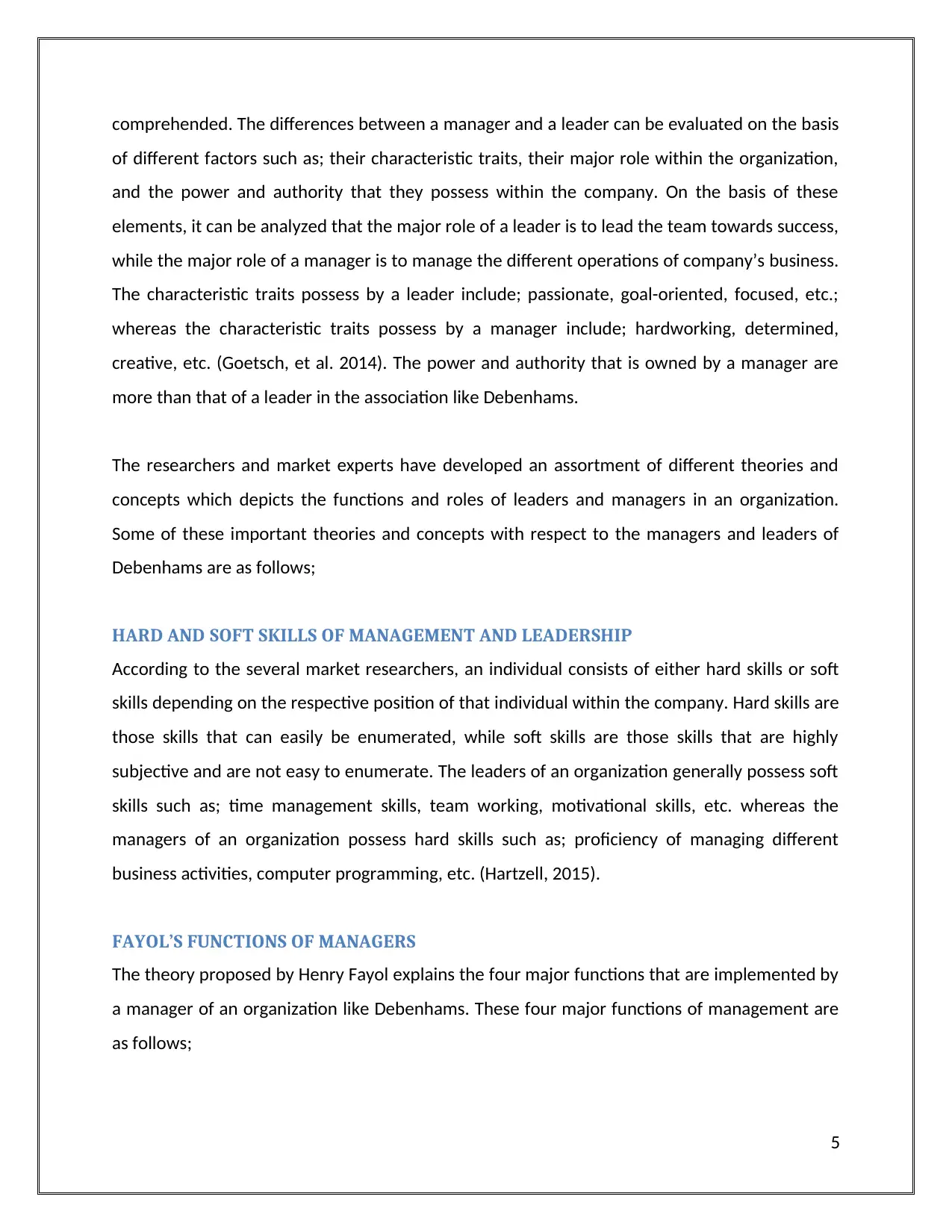
comprehended. The differences between a manager and a leader can be evaluated on the basis
of different factors such as; their characteristic traits, their major role within the organization,
and the power and authority that they possess within the company. On the basis of these
elements, it can be analyzed that the major role of a leader is to lead the team towards success,
while the major role of a manager is to manage the different operations of company’s business.
The characteristic traits possess by a leader include; passionate, goal-oriented, focused, etc.;
whereas the characteristic traits possess by a manager include; hardworking, determined,
creative, etc. (Goetsch, et al. 2014). The power and authority that is owned by a manager are
more than that of a leader in the association like Debenhams.
The researchers and market experts have developed an assortment of different theories and
concepts which depicts the functions and roles of leaders and managers in an organization.
Some of these important theories and concepts with respect to the managers and leaders of
Debenhams are as follows;
HARD AND SOFT SKILLS OF MANAGEMENT AND LEADERSHIP
According to the several market researchers, an individual consists of either hard skills or soft
skills depending on the respective position of that individual within the company. Hard skills are
those skills that can easily be enumerated, while soft skills are those skills that are highly
subjective and are not easy to enumerate. The leaders of an organization generally possess soft
skills such as; time management skills, team working, motivational skills, etc. whereas the
managers of an organization possess hard skills such as; proficiency of managing different
business activities, computer programming, etc. (Hartzell, 2015).
FAYOL’S FUNCTIONS OF MANAGERS
The theory proposed by Henry Fayol explains the four major functions that are implemented by
a manager of an organization like Debenhams. These four major functions of management are
as follows;
5
of different factors such as; their characteristic traits, their major role within the organization,
and the power and authority that they possess within the company. On the basis of these
elements, it can be analyzed that the major role of a leader is to lead the team towards success,
while the major role of a manager is to manage the different operations of company’s business.
The characteristic traits possess by a leader include; passionate, goal-oriented, focused, etc.;
whereas the characteristic traits possess by a manager include; hardworking, determined,
creative, etc. (Goetsch, et al. 2014). The power and authority that is owned by a manager are
more than that of a leader in the association like Debenhams.
The researchers and market experts have developed an assortment of different theories and
concepts which depicts the functions and roles of leaders and managers in an organization.
Some of these important theories and concepts with respect to the managers and leaders of
Debenhams are as follows;
HARD AND SOFT SKILLS OF MANAGEMENT AND LEADERSHIP
According to the several market researchers, an individual consists of either hard skills or soft
skills depending on the respective position of that individual within the company. Hard skills are
those skills that can easily be enumerated, while soft skills are those skills that are highly
subjective and are not easy to enumerate. The leaders of an organization generally possess soft
skills such as; time management skills, team working, motivational skills, etc. whereas the
managers of an organization possess hard skills such as; proficiency of managing different
business activities, computer programming, etc. (Hartzell, 2015).
FAYOL’S FUNCTIONS OF MANAGERS
The theory proposed by Henry Fayol explains the four major functions that are implemented by
a manager of an organization like Debenhams. These four major functions of management are
as follows;
5
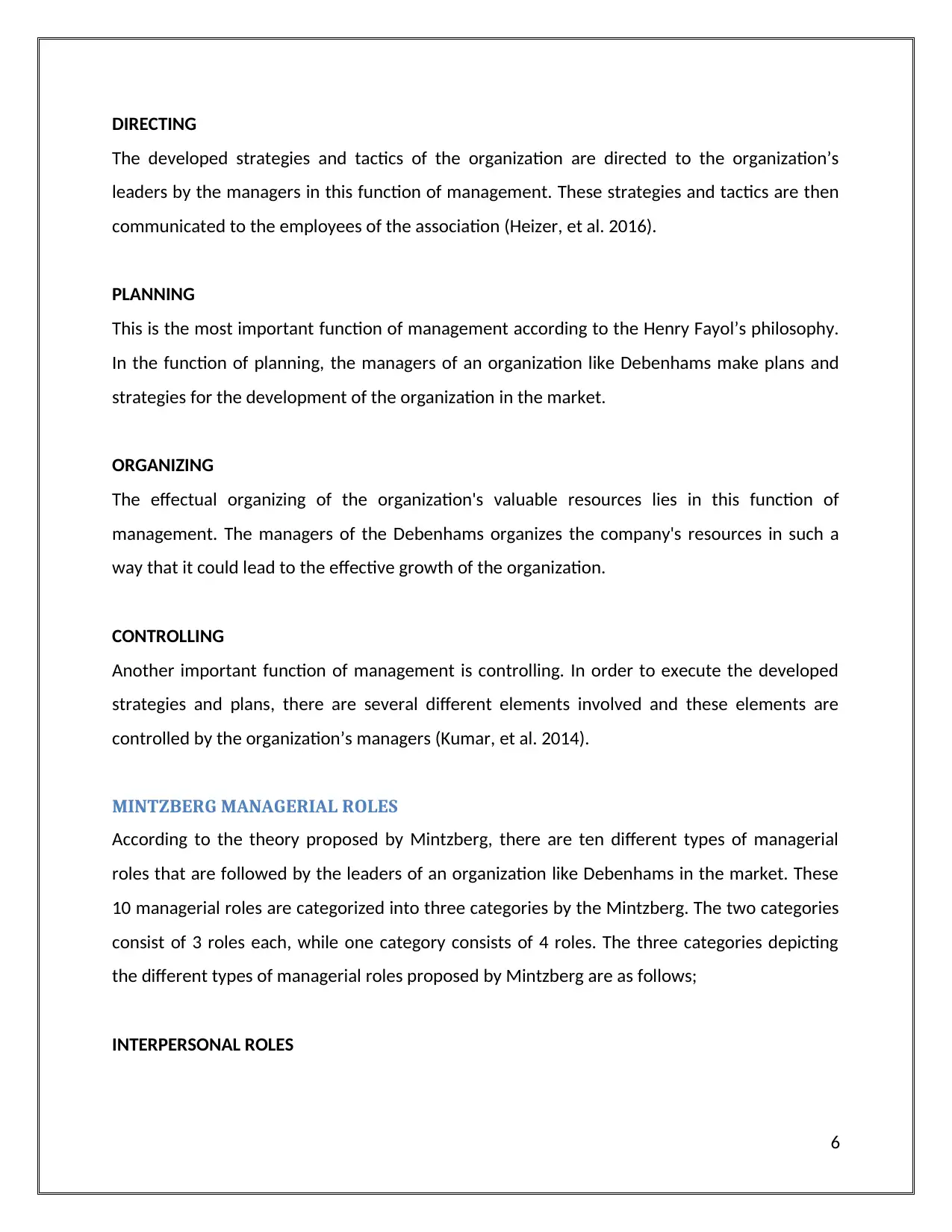
DIRECTING
The developed strategies and tactics of the organization are directed to the organization’s
leaders by the managers in this function of management. These strategies and tactics are then
communicated to the employees of the association (Heizer, et al. 2016).
PLANNING
This is the most important function of management according to the Henry Fayol’s philosophy.
In the function of planning, the managers of an organization like Debenhams make plans and
strategies for the development of the organization in the market.
ORGANIZING
The effectual organizing of the organization's valuable resources lies in this function of
management. The managers of the Debenhams organizes the company's resources in such a
way that it could lead to the effective growth of the organization.
CONTROLLING
Another important function of management is controlling. In order to execute the developed
strategies and plans, there are several different elements involved and these elements are
controlled by the organization’s managers (Kumar, et al. 2014).
MINTZBERG MANAGERIAL ROLES
According to the theory proposed by Mintzberg, there are ten different types of managerial
roles that are followed by the leaders of an organization like Debenhams in the market. These
10 managerial roles are categorized into three categories by the Mintzberg. The two categories
consist of 3 roles each, while one category consists of 4 roles. The three categories depicting
the different types of managerial roles proposed by Mintzberg are as follows;
INTERPERSONAL ROLES
6
The developed strategies and tactics of the organization are directed to the organization’s
leaders by the managers in this function of management. These strategies and tactics are then
communicated to the employees of the association (Heizer, et al. 2016).
PLANNING
This is the most important function of management according to the Henry Fayol’s philosophy.
In the function of planning, the managers of an organization like Debenhams make plans and
strategies for the development of the organization in the market.
ORGANIZING
The effectual organizing of the organization's valuable resources lies in this function of
management. The managers of the Debenhams organizes the company's resources in such a
way that it could lead to the effective growth of the organization.
CONTROLLING
Another important function of management is controlling. In order to execute the developed
strategies and plans, there are several different elements involved and these elements are
controlled by the organization’s managers (Kumar, et al. 2014).
MINTZBERG MANAGERIAL ROLES
According to the theory proposed by Mintzberg, there are ten different types of managerial
roles that are followed by the leaders of an organization like Debenhams in the market. These
10 managerial roles are categorized into three categories by the Mintzberg. The two categories
consist of 3 roles each, while one category consists of 4 roles. The three categories depicting
the different types of managerial roles proposed by Mintzberg are as follows;
INTERPERSONAL ROLES
6
⊘ This is a preview!⊘
Do you want full access?
Subscribe today to unlock all pages.

Trusted by 1+ million students worldwide
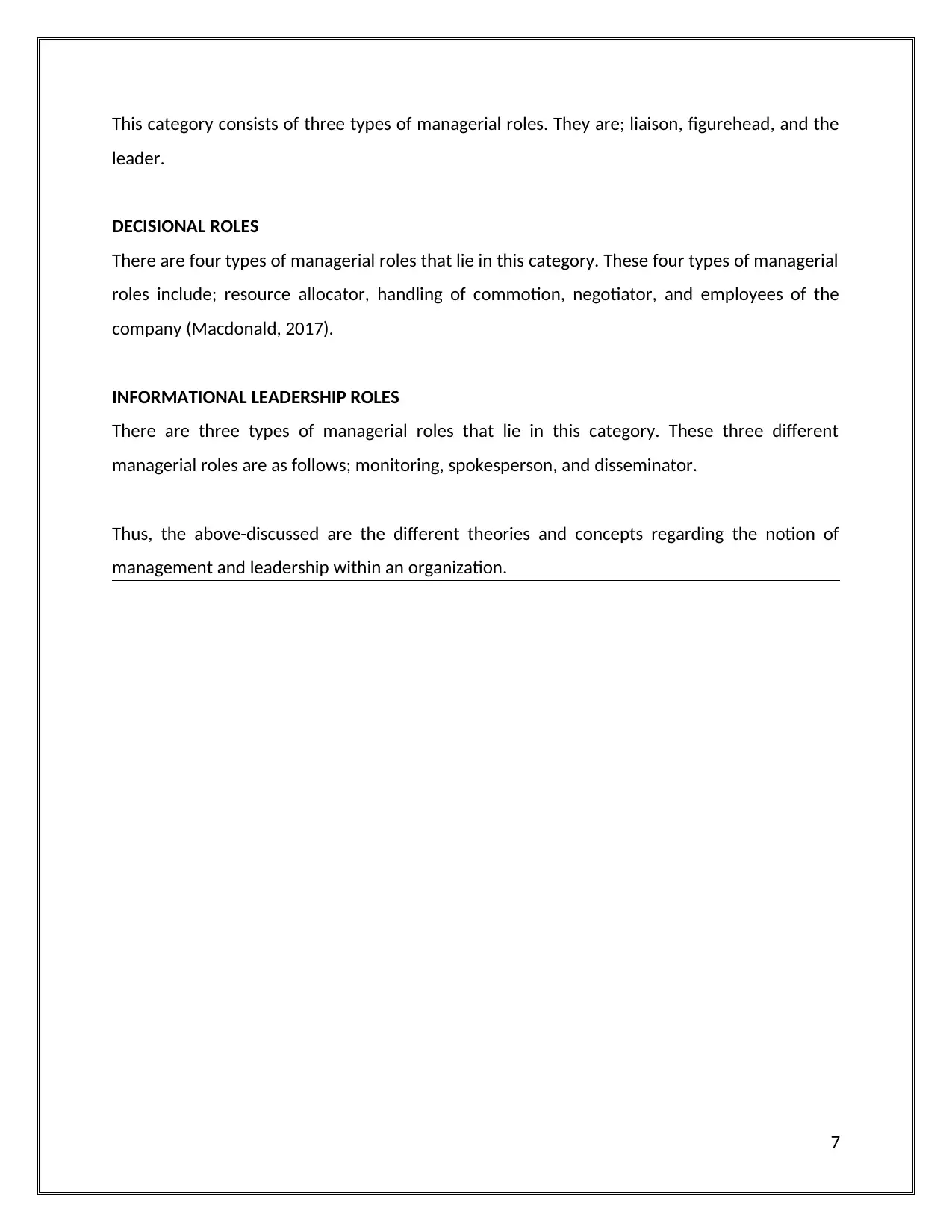
This category consists of three types of managerial roles. They are; liaison, figurehead, and the
leader.
DECISIONAL ROLES
There are four types of managerial roles that lie in this category. These four types of managerial
roles include; resource allocator, handling of commotion, negotiator, and employees of the
company (Macdonald, 2017).
INFORMATIONAL LEADERSHIP ROLES
There are three types of managerial roles that lie in this category. These three different
managerial roles are as follows; monitoring, spokesperson, and disseminator.
Thus, the above-discussed are the different theories and concepts regarding the notion of
management and leadership within an organization.
7
leader.
DECISIONAL ROLES
There are four types of managerial roles that lie in this category. These four types of managerial
roles include; resource allocator, handling of commotion, negotiator, and employees of the
company (Macdonald, 2017).
INFORMATIONAL LEADERSHIP ROLES
There are three types of managerial roles that lie in this category. These three different
managerial roles are as follows; monitoring, spokesperson, and disseminator.
Thus, the above-discussed are the different theories and concepts regarding the notion of
management and leadership within an organization.
7
Paraphrase This Document
Need a fresh take? Get an instant paraphrase of this document with our AI Paraphraser
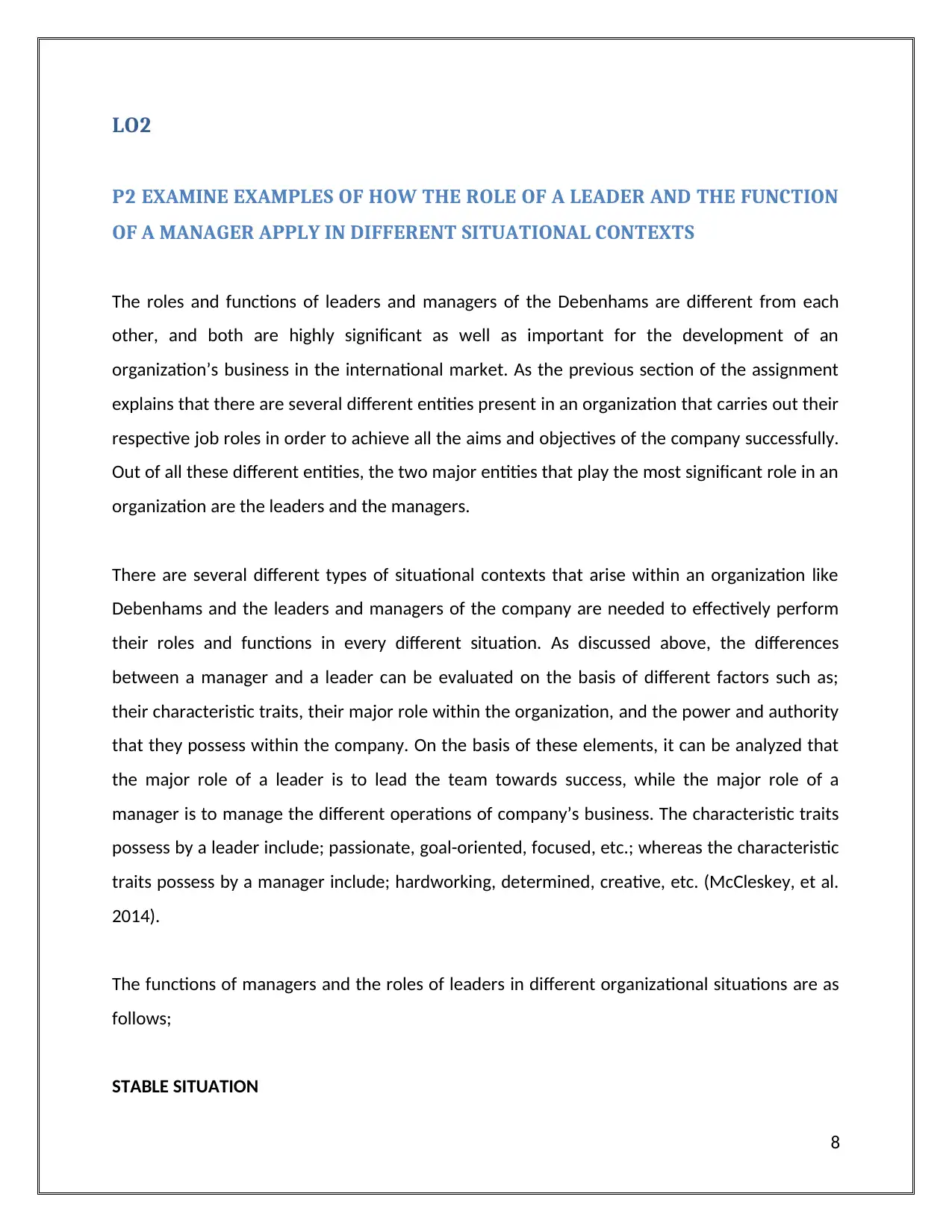
LO2
P2 EXAMINE EXAMPLES OF HOW THE ROLE OF A LEADER AND THE FUNCTION
OF A MANAGER APPLY IN DIFFERENT SITUATIONAL CONTEXTS
The roles and functions of leaders and managers of the Debenhams are different from each
other, and both are highly significant as well as important for the development of an
organization’s business in the international market. As the previous section of the assignment
explains that there are several different entities present in an organization that carries out their
respective job roles in order to achieve all the aims and objectives of the company successfully.
Out of all these different entities, the two major entities that play the most significant role in an
organization are the leaders and the managers.
There are several different types of situational contexts that arise within an organization like
Debenhams and the leaders and managers of the company are needed to effectively perform
their roles and functions in every different situation. As discussed above, the differences
between a manager and a leader can be evaluated on the basis of different factors such as;
their characteristic traits, their major role within the organization, and the power and authority
that they possess within the company. On the basis of these elements, it can be analyzed that
the major role of a leader is to lead the team towards success, while the major role of a
manager is to manage the different operations of company’s business. The characteristic traits
possess by a leader include; passionate, goal-oriented, focused, etc.; whereas the characteristic
traits possess by a manager include; hardworking, determined, creative, etc. (McCleskey, et al.
2014).
The functions of managers and the roles of leaders in different organizational situations are as
follows;
STABLE SITUATION
8
P2 EXAMINE EXAMPLES OF HOW THE ROLE OF A LEADER AND THE FUNCTION
OF A MANAGER APPLY IN DIFFERENT SITUATIONAL CONTEXTS
The roles and functions of leaders and managers of the Debenhams are different from each
other, and both are highly significant as well as important for the development of an
organization’s business in the international market. As the previous section of the assignment
explains that there are several different entities present in an organization that carries out their
respective job roles in order to achieve all the aims and objectives of the company successfully.
Out of all these different entities, the two major entities that play the most significant role in an
organization are the leaders and the managers.
There are several different types of situational contexts that arise within an organization like
Debenhams and the leaders and managers of the company are needed to effectively perform
their roles and functions in every different situation. As discussed above, the differences
between a manager and a leader can be evaluated on the basis of different factors such as;
their characteristic traits, their major role within the organization, and the power and authority
that they possess within the company. On the basis of these elements, it can be analyzed that
the major role of a leader is to lead the team towards success, while the major role of a
manager is to manage the different operations of company’s business. The characteristic traits
possess by a leader include; passionate, goal-oriented, focused, etc.; whereas the characteristic
traits possess by a manager include; hardworking, determined, creative, etc. (McCleskey, et al.
2014).
The functions of managers and the roles of leaders in different organizational situations are as
follows;
STABLE SITUATION
8
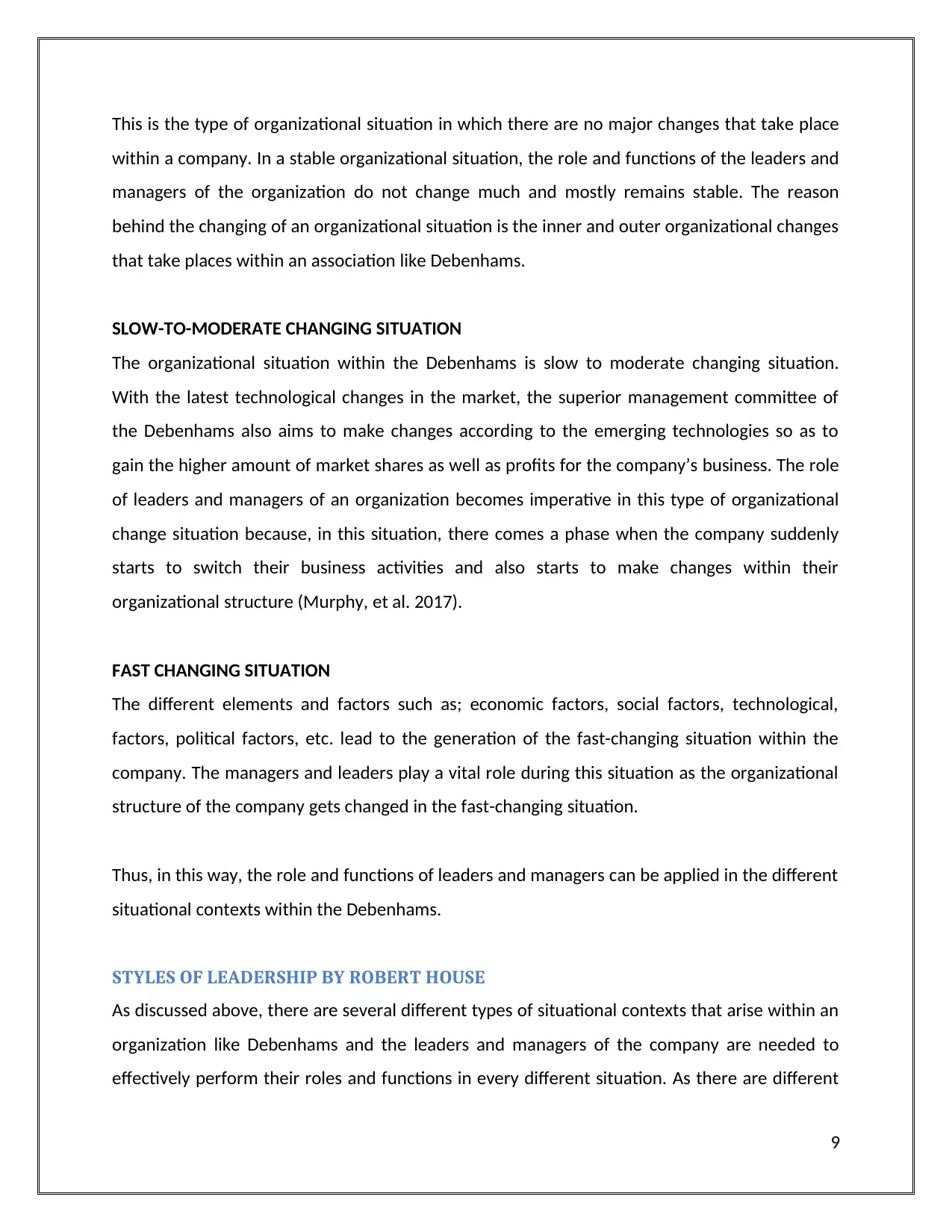
This is the type of organizational situation in which there are no major changes that take place
within a company. In a stable organizational situation, the role and functions of the leaders and
managers of the organization do not change much and mostly remains stable. The reason
behind the changing of an organizational situation is the inner and outer organizational changes
that take places within an association like Debenhams.
SLOW-TO-MODERATE CHANGING SITUATION
The organizational situation within the Debenhams is slow to moderate changing situation.
With the latest technological changes in the market, the superior management committee of
the Debenhams also aims to make changes according to the emerging technologies so as to
gain the higher amount of market shares as well as profits for the company’s business. The role
of leaders and managers of an organization becomes imperative in this type of organizational
change situation because, in this situation, there comes a phase when the company suddenly
starts to switch their business activities and also starts to make changes within their
organizational structure (Murphy, et al. 2017).
FAST CHANGING SITUATION
The different elements and factors such as; economic factors, social factors, technological,
factors, political factors, etc. lead to the generation of the fast-changing situation within the
company. The managers and leaders play a vital role during this situation as the organizational
structure of the company gets changed in the fast-changing situation.
Thus, in this way, the role and functions of leaders and managers can be applied in the different
situational contexts within the Debenhams.
STYLES OF LEADERSHIP BY ROBERT HOUSE
As discussed above, there are several different types of situational contexts that arise within an
organization like Debenhams and the leaders and managers of the company are needed to
effectively perform their roles and functions in every different situation. As there are different
9
within a company. In a stable organizational situation, the role and functions of the leaders and
managers of the organization do not change much and mostly remains stable. The reason
behind the changing of an organizational situation is the inner and outer organizational changes
that take places within an association like Debenhams.
SLOW-TO-MODERATE CHANGING SITUATION
The organizational situation within the Debenhams is slow to moderate changing situation.
With the latest technological changes in the market, the superior management committee of
the Debenhams also aims to make changes according to the emerging technologies so as to
gain the higher amount of market shares as well as profits for the company’s business. The role
of leaders and managers of an organization becomes imperative in this type of organizational
change situation because, in this situation, there comes a phase when the company suddenly
starts to switch their business activities and also starts to make changes within their
organizational structure (Murphy, et al. 2017).
FAST CHANGING SITUATION
The different elements and factors such as; economic factors, social factors, technological,
factors, political factors, etc. lead to the generation of the fast-changing situation within the
company. The managers and leaders play a vital role during this situation as the organizational
structure of the company gets changed in the fast-changing situation.
Thus, in this way, the role and functions of leaders and managers can be applied in the different
situational contexts within the Debenhams.
STYLES OF LEADERSHIP BY ROBERT HOUSE
As discussed above, there are several different types of situational contexts that arise within an
organization like Debenhams and the leaders and managers of the company are needed to
effectively perform their roles and functions in every different situation. As there are different
9
⊘ This is a preview!⊘
Do you want full access?
Subscribe today to unlock all pages.

Trusted by 1+ million students worldwide
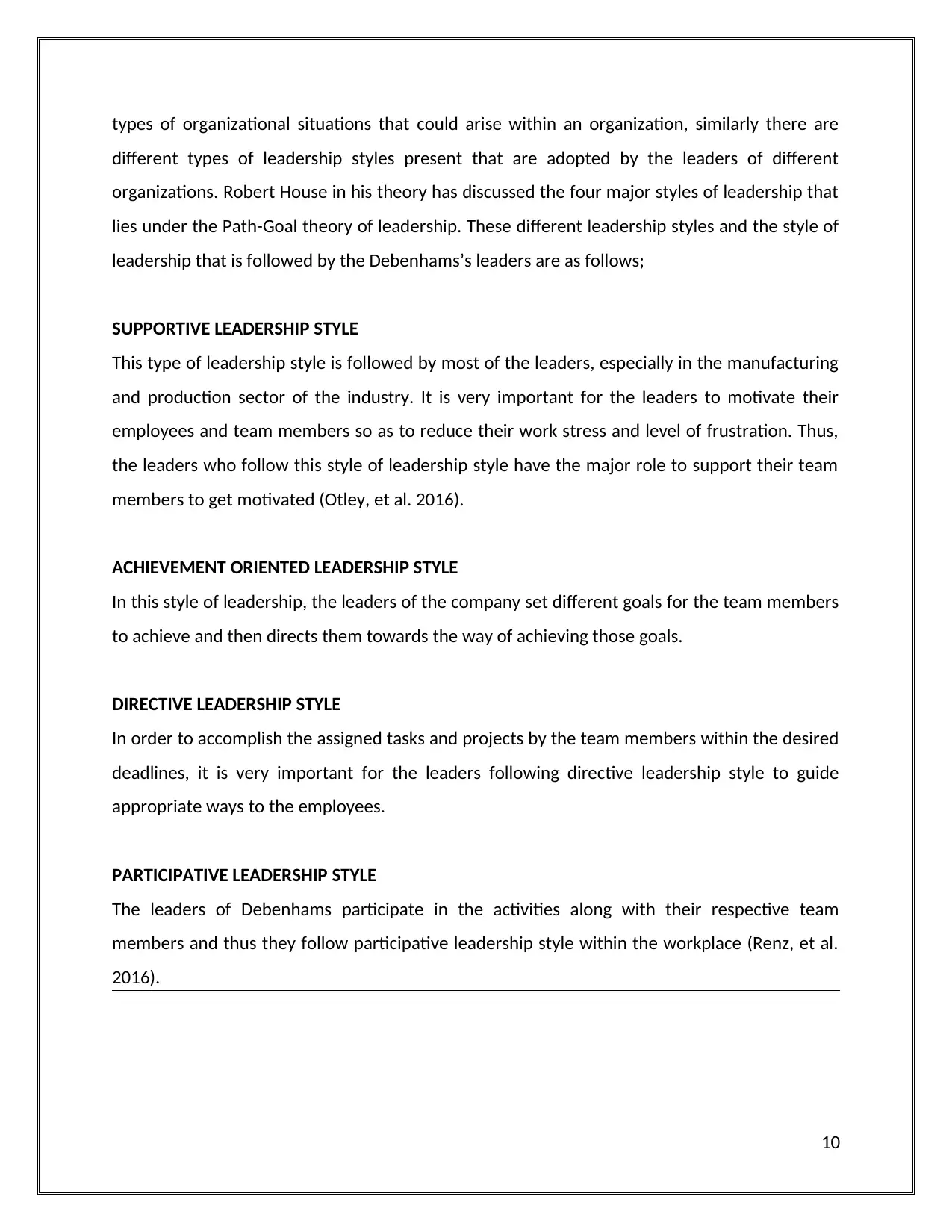
types of organizational situations that could arise within an organization, similarly there are
different types of leadership styles present that are adopted by the leaders of different
organizations. Robert House in his theory has discussed the four major styles of leadership that
lies under the Path-Goal theory of leadership. These different leadership styles and the style of
leadership that is followed by the Debenhams’s leaders are as follows;
SUPPORTIVE LEADERSHIP STYLE
This type of leadership style is followed by most of the leaders, especially in the manufacturing
and production sector of the industry. It is very important for the leaders to motivate their
employees and team members so as to reduce their work stress and level of frustration. Thus,
the leaders who follow this style of leadership style have the major role to support their team
members to get motivated (Otley, et al. 2016).
ACHIEVEMENT ORIENTED LEADERSHIP STYLE
In this style of leadership, the leaders of the company set different goals for the team members
to achieve and then directs them towards the way of achieving those goals.
DIRECTIVE LEADERSHIP STYLE
In order to accomplish the assigned tasks and projects by the team members within the desired
deadlines, it is very important for the leaders following directive leadership style to guide
appropriate ways to the employees.
PARTICIPATIVE LEADERSHIP STYLE
The leaders of Debenhams participate in the activities along with their respective team
members and thus they follow participative leadership style within the workplace (Renz, et al.
2016).
10
different types of leadership styles present that are adopted by the leaders of different
organizations. Robert House in his theory has discussed the four major styles of leadership that
lies under the Path-Goal theory of leadership. These different leadership styles and the style of
leadership that is followed by the Debenhams’s leaders are as follows;
SUPPORTIVE LEADERSHIP STYLE
This type of leadership style is followed by most of the leaders, especially in the manufacturing
and production sector of the industry. It is very important for the leaders to motivate their
employees and team members so as to reduce their work stress and level of frustration. Thus,
the leaders who follow this style of leadership style have the major role to support their team
members to get motivated (Otley, et al. 2016).
ACHIEVEMENT ORIENTED LEADERSHIP STYLE
In this style of leadership, the leaders of the company set different goals for the team members
to achieve and then directs them towards the way of achieving those goals.
DIRECTIVE LEADERSHIP STYLE
In order to accomplish the assigned tasks and projects by the team members within the desired
deadlines, it is very important for the leaders following directive leadership style to guide
appropriate ways to the employees.
PARTICIPATIVE LEADERSHIP STYLE
The leaders of Debenhams participate in the activities along with their respective team
members and thus they follow participative leadership style within the workplace (Renz, et al.
2016).
10
Paraphrase This Document
Need a fresh take? Get an instant paraphrase of this document with our AI Paraphraser
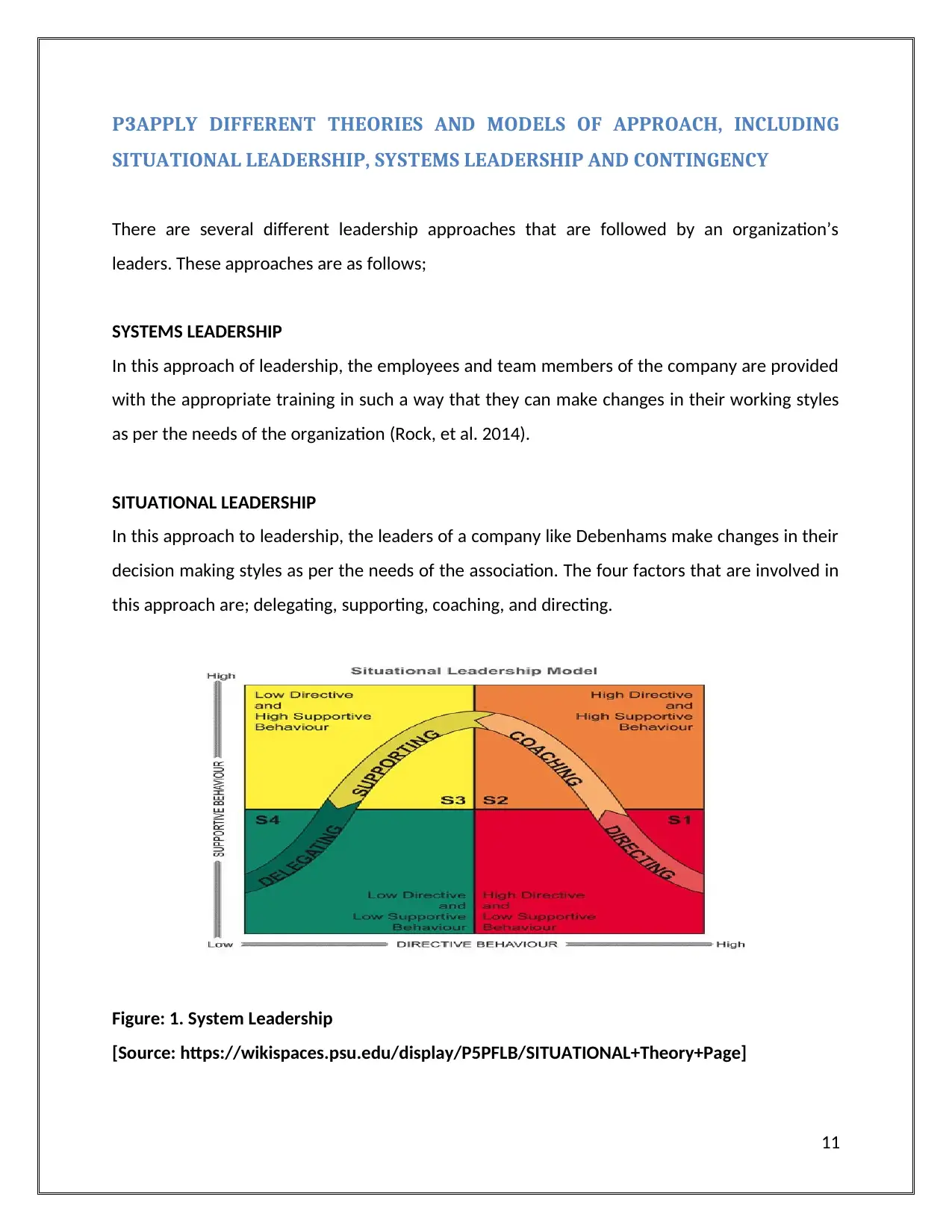
P3APPLY DIFFERENT THEORIES AND MODELS OF APPROACH, INCLUDING
SITUATIONAL LEADERSHIP, SYSTEMS LEADERSHIP AND CONTINGENCY
There are several different leadership approaches that are followed by an organization’s
leaders. These approaches are as follows;
SYSTEMS LEADERSHIP
In this approach of leadership, the employees and team members of the company are provided
with the appropriate training in such a way that they can make changes in their working styles
as per the needs of the organization (Rock, et al. 2014).
SITUATIONAL LEADERSHIP
In this approach to leadership, the leaders of a company like Debenhams make changes in their
decision making styles as per the needs of the association. The four factors that are involved in
this approach are; delegating, supporting, coaching, and directing.
Figure: 1. System Leadership
[Source: https://wikispaces.psu.edu/display/P5PFLB/SITUATIONAL+Theory+Page]
11
SITUATIONAL LEADERSHIP, SYSTEMS LEADERSHIP AND CONTINGENCY
There are several different leadership approaches that are followed by an organization’s
leaders. These approaches are as follows;
SYSTEMS LEADERSHIP
In this approach of leadership, the employees and team members of the company are provided
with the appropriate training in such a way that they can make changes in their working styles
as per the needs of the organization (Rock, et al. 2014).
SITUATIONAL LEADERSHIP
In this approach to leadership, the leaders of a company like Debenhams make changes in their
decision making styles as per the needs of the association. The four factors that are involved in
this approach are; delegating, supporting, coaching, and directing.
Figure: 1. System Leadership
[Source: https://wikispaces.psu.edu/display/P5PFLB/SITUATIONAL+Theory+Page]
11
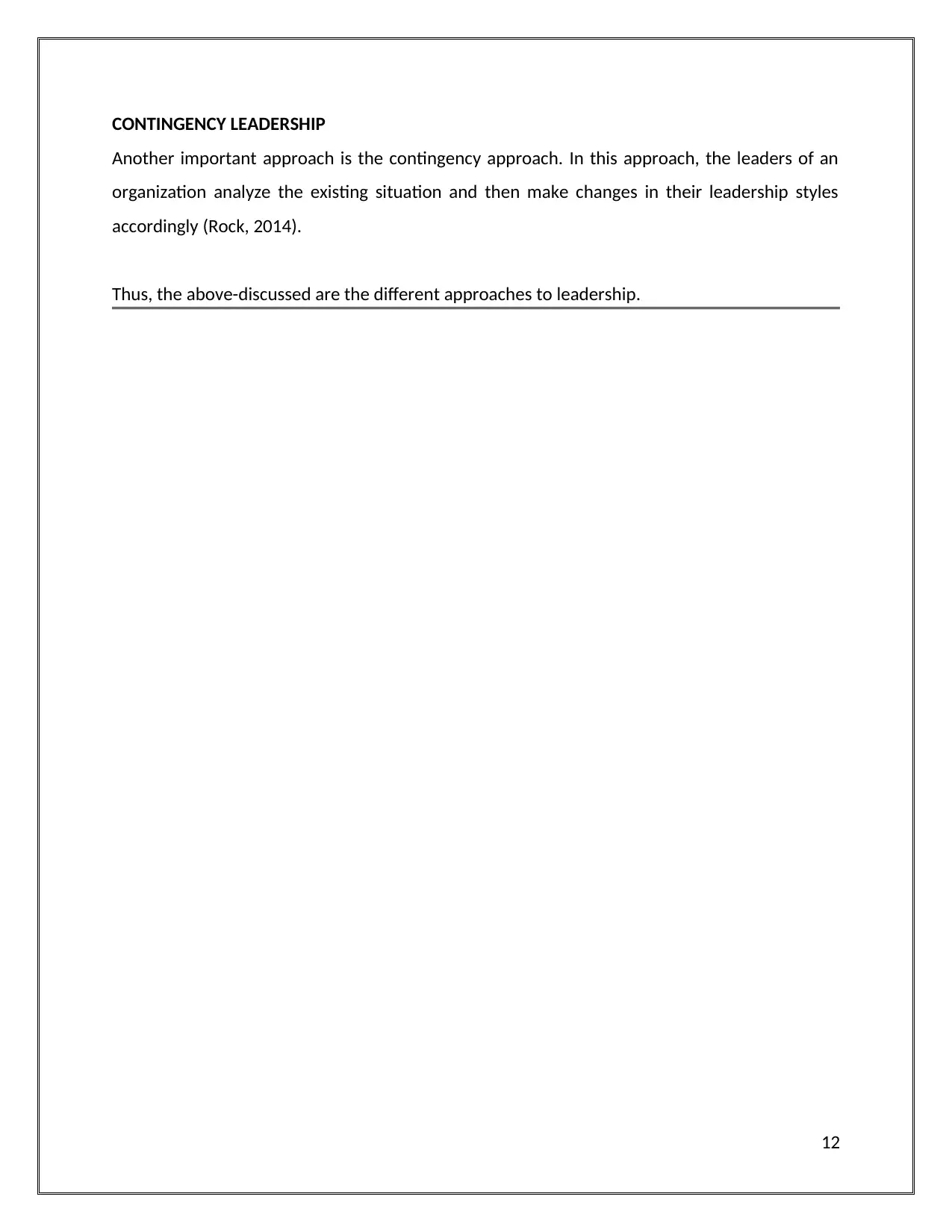
CONTINGENCY LEADERSHIP
Another important approach is the contingency approach. In this approach, the leaders of an
organization analyze the existing situation and then make changes in their leadership styles
accordingly (Rock, 2014).
Thus, the above-discussed are the different approaches to leadership.
12
Another important approach is the contingency approach. In this approach, the leaders of an
organization analyze the existing situation and then make changes in their leadership styles
accordingly (Rock, 2014).
Thus, the above-discussed are the different approaches to leadership.
12
⊘ This is a preview!⊘
Do you want full access?
Subscribe today to unlock all pages.

Trusted by 1+ million students worldwide
1 out of 23
Related Documents
Your All-in-One AI-Powered Toolkit for Academic Success.
+13062052269
info@desklib.com
Available 24*7 on WhatsApp / Email
![[object Object]](/_next/static/media/star-bottom.7253800d.svg)
Unlock your academic potential
Copyright © 2020–2025 A2Z Services. All Rights Reserved. Developed and managed by ZUCOL.




